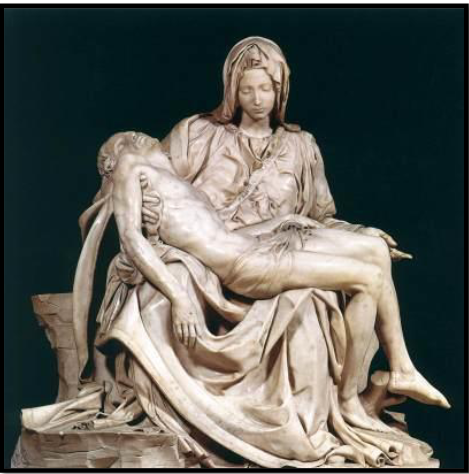
The subject matter of Michelangelo’s Pieta portrait is the body of Jesus Christ and the Virgin Mary. The sculpture shows the scene of Christ’s body after being removed from the cross and the overwhelming sorrow that Mary had for Jesus. This artwork is a picture of one of the seven sorrows of the Virgin Mary, as experienced in the Catholic belief. The portrait was built in Italy during the High Renaissance era and is iconographic due to the holy images depicted in it. For example, Mary is not touching the skin of Jesus Christ directly, which demonstrates his sacredness implicitly (Steinberg 2). Overall, this sculpture is arguably the best example of a larger range of Pieta works, which convey a heartbroken Mary cradling Jesus’ body after the Crucifixion. Michelangelo’s Pieta is a vital artwork from a historical and cultural perspective because it balances the High Renaissance concepts of classical loveliness with naturalism and distinctly Christian subject matter. Michelangelo adopted mixed of Renaissance and humanism concepts with classical standards of beauty aligned with poses that supported naturalism making his work beautiful and unique. Michelangelo’s Pieta is considered one of the best Italian Renaissance works of all time (Steinberg 5). It is also one of the famous subjects practiced among the artists of northern Europe, which allows discussing it within an established cultural tradition. In spatial terms, the sculpture depicts a triangular or pyramidal shape. Mary creates a triangular shape with her head, then her shoulders, and then the cape that flows down her arms to the bottom. The head of Mary is positioned at the triangle’s top, while Jesus’s feet and the folds of her garment comprise the lower ones. The triangle’s third point is the base where Mary props her feet. Michelangelo also applies other shapes within the triangular shape to stress other points. For instance, the face of Mary is oval, and the body of Jesus Christ forms an obtuse triangle (Steinberg 7). Mary’s face is small and delicate, with beautiful features that symbolize longevity and purity. The triangular shape illustrates the Holy Trinity that symbolizes God in three factors of religion, the Father, the Son, and the Holy Spirit. The image appears to present a complexion of both actual and implied texture. The skin of Jesus and Mary seems to have texture in all their hands and faces (Hibbard 213). The hand of Jesus has fine lines forming veins and creating the fingers and knuckles more realistic.
Works Cited
Hibbard, Howard. “Michelangelo’s Medicean Architecture.” Michelangelo, vol. 1, no. 3, 2018, pp. 209-219.
Steinberg, Leo. Michelangelo’s Sculpture: Selected Essays. University of Chicago, 2018.